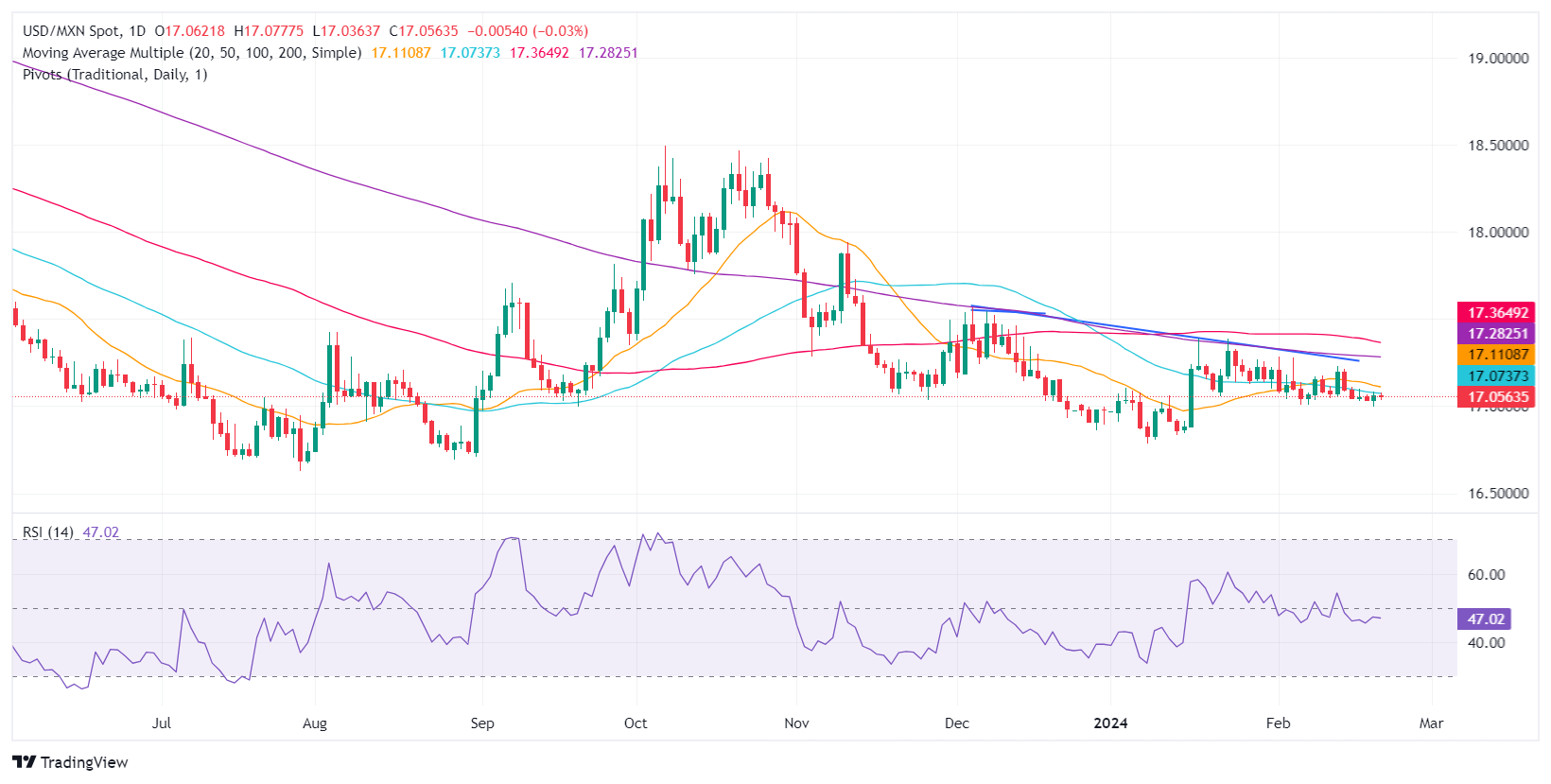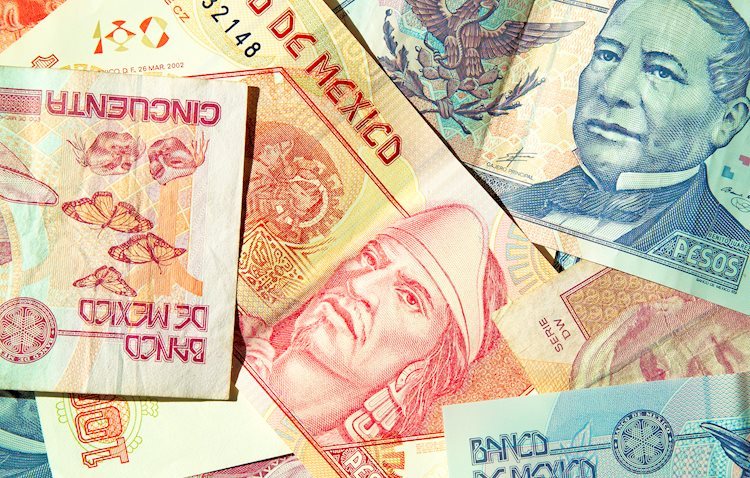Mexican Peso remains firm as the US Dollar weakens despite Fed’s delaying rate cuts
- Mexican Peso gains traction despite worse-than-expected Mexico's Retail Sales, post Fed’s meeting minutes.
- Fed's insistence on inflation confidence before rate adjustments impacts currency markets.
- Weak retail sales and economic contraction in Mexico may influence Banxico's upcoming rate decision.
The Mexican Peso (MXN) extended its gains against the US Dollar (USD) as the Federal Reserve released its latest meeting minutes, which showed that Fed officials remain reluctant to cut rates too soon. Even though policymakers acknowledged that economic risks are skewed to the downside, some officials noted that inflation could stall. At the time of writing, the USD/MXN exchanges hands at 17.04, down 0.06%.
The minutes showed the Fed noted they did not see it appropriate to lower interest rates until they gained “greater confidence” in inflation moving sustainably towards 2%. While they said the risks of achieving both mandates, they remained “highly attentive” to inflationary risks.
Earlier, Mexico’s National Statistics Agency revealed that Retail Sales plunged in December, in both monthly and annual figures, an indication that consumers are feeling the pain of higher interest rates set by the Bank of Mexico (Banxico). Today’s data summed to Monday’s Indicator of Economic Activity (IOAE), suggesting the economy shrank -0.7% MoM in January, which could weigh on Banxico’s decision to lower rates at the March meeting.
Daily digest market movers: Mexican Peso fluctuates between minimal gains/losses ahead of Fed Minutes
- Mexico’s Retail Sales dropped -0.9% MoM, below estimates of 0.2% expansion. Yearly figures plummeted -0.2% vs. the forecast of a 2.5% increase.
- The Mexican currency could depreciate further if the Mexican government fails to resolve the steel and aluminum dispute with the United States. US Trade Representative Katherine Tai warned the US could reimpose tariffs on the aforementioned commodities.
- Mexico’s economic schedule will feature the release of the Gross Domestic Product (GDP) and February’s Mid-Month inflation data on Thursday.
- GDP is projected to have grown 0.1% in Q4 2023 and 2.4% YoY.
- Mid-month underlying inflation for February is foreseen cooling from 4.78% to 4.67 YoY, while headline inflation is projected to drop from 4.9% to 4.7%.
- On Tuesday, the Conference Board (CB) revealed its Leading Economic Index (LEI), which no longer signals an upcoming recession in the US.
- Recently, Richmond Fed President Thomas Barkin said the latest inflation reports were “less good,” adding the US has “a ways to go” to achieve a soft landing.
- Traders will get further cues from US S&P Global PMIs, Initial Jobless Claims data and the Chicago Fed National Activity Index. The latter is usually a prelude to the Institute for Supply Management’s (ISM) Manufacturing PMI.
- US economic data related to price pressures should greatly influence Federal Reserve officials. Although opening the door to easing policy, Fed officials have expressed numerous times that they will not rush rate cuts.
- Fed’s Bostic said patience is required, and he foresees two rate cuts, which could begin in the summer if the data justifies it. Fed’s Daly said, “We will need to resist the temptation to act quickly when patience is needed and be prepared to respond agilely as the economy evolves.”
- Market players are expecting the first rate cut by the Federal Reserve at the June monetary policy meeting as they have trimmed odds for March and May.
Technical analysis: Mexican Peso prints minimal losses as USD/MXN breaks above 17.05
The USD/MXN remains in consolidation, at around 17.05, awaiting a fresh catalyst. If buyers regain the 50-day Simple Moving Average (SMA) at 17.07, the pair could rally toward the 200-day SMA at 17.28. A breach of the latter will expose the 100-day SMA at 17.38, ahead of the 17.50 mark.
On the other hand, if sellers’ step in and cap USD/MXN’s upside, they need to push prices below the 17.00 figure. Once cleared, the next support would be the current year-to-date (YTD) low of 16.78, followed by the 2023 low of 16.62.
USD/MXN Price Action – Daily Chart

Mexican Peso FAQs
What key factors drive the Mexican Peso?
The Mexican Peso (MXN) is the most traded currency among its Latin American peers. Its value is broadly determined by the performance of the Mexican economy, the country’s central bank’s policy, the amount of foreign investment in the country and even the levels of remittances sent by Mexicans who live abroad, particularly in the United States. Geopolitical trends can also move MXN: for example, the process of nearshoring – or the decision by some firms to relocate manufacturing capacity and supply chains closer to their home countries – is also seen as a catalyst for the Mexican currency as the country is considered a key manufacturing hub in the American continent. Another catalyst for MXN is Oil prices as Mexico is a key exporter of the commodity.
How do decisions of the Banxico impact the Mexican Peso?
The main objective of Mexico’s central bank, also known as Banxico, is to maintain inflation at low and stable levels (at or close to its target of 3%, the midpoint in a tolerance band of between 2% and 4%). To this end, the bank sets an appropriate level of interest rates. When inflation is too high, Banxico will attempt to tame it by raising interest rates, making it more expensive for households and businesses to borrow money, thus cooling demand and the overall economy. Higher interest rates are generally positive for the Mexican Peso (MXN) as they lead to higher yields, making the country a more attractive place for investors. On the contrary, lower interest rates tend to weaken MXN.
How does economic data influence the value of the Mexican Peso?
Macroeconomic data releases are key to assess the state of the economy and can have an impact on the Mexican Peso (MXN) valuation. A strong Mexican economy, based on high economic growth, low unemployment and high confidence is good for MXN. Not only does it attract more foreign investment but it may encourage the Bank of Mexico (Banxico) to increase interest rates, particularly if this strength comes together with elevated inflation. However, if economic data is weak, MXN is likely to depreciate.
How does broader risk sentiment impact the Mexican Peso?
As an emerging-market currency, the Mexican Peso (MXN) tends to strive during risk-on periods, or when investors perceive that broader market risks are low and thus are eager to engage with investments that carry a higher risk. Conversely, MXN tends to weaken at times of market turbulence or economic uncertainty as investors tend to sell higher-risk assets and flee to the more-stable safe havens.
Forex News
Keep up with the financial markets, know what's happening and what is affecting the markets with our latest market updates. Analyze market movers, trends and build your trading strategies accordingly.
